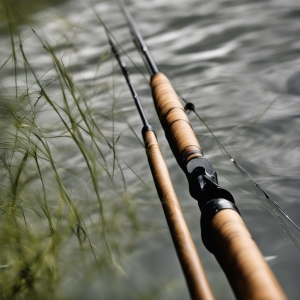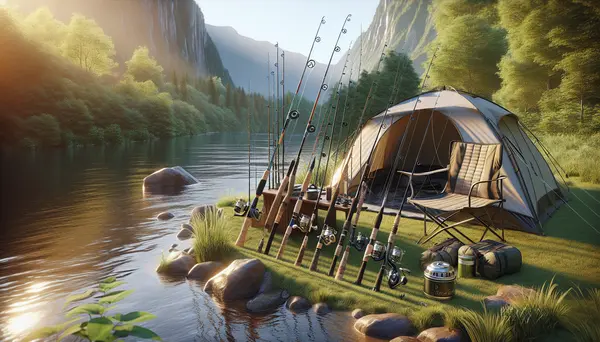Table of Contents:
Introduction to Selecting the Right Fishing Rod
If you've ever wandered into a tackle shop, you know the overwhelming variety of fishing rods to choose from. But how do you know which one is the best for you? As with any tool, the right fishing rod will significantly enhance your fishing experience. This guide will help you navigate the sea of options and find your perfect fishing companion.
Understanding Various Types of Fishing Rods
Before diving into the specifics of selecting your ideal fishing rod, it's vital to understand the different types available. Different fishing situations call for various rods, and understanding the differences will make your selection process easier. Let's take a closer look at each type.
Pros and Cons of Various Fishing Rods
| Type of Fishing Rod | Pros | Cons |
|---|---|---|
| Spinning Rods | Easy to use, Versatile, Good for light tackle | Not suitable for heavy lines and lures |
| Casting Rods | Great casting distance, Power to handle heavy fish | Harder to master, Not suitable for light lures |
| Fly Rods | Performs well in variety of environments, Offers a unique fishing experience | Requires more skill and practice, Equipment can be expensive |
| Telescopic Rods | Portable and compact, Good for long distance casting | Can be difficult to handle, Not as durable |
| Ice Fishing Rods | Specialized for ice fishing, Compact and easy to transport | Not suitable for other types of fishing, Limited casting capabilities |
Spinning Rods

Usually lightweight, these rods are perfect for casting light lures, making them ideal for catching small to medium-sized fish. The guides and reel seat are located at the bottom of the rod, making it quite comfortable to hold.
Cast Rods
Cast rods are best for dealing with heavier lures and baits. The reel seat and guides are located on top of the rod, enabling a better pull on the line. These rods are a good choice for catching larger fish species.
Telescopic Rods

For anglers who value portability, a telescopic fishing rod is a prime choice. These rods can be extended and retracted, making them easy to pack and carry. However, their length when extended can make casting long distances a breeze.
Sea fishing Rods
Designed for saltwater fishing, these rods are made of corrosion-resistant materials. They're typically heavier and sturdier to withstand big, powerful fish commonly found in oceans.
Evaluating Rod Materials: Fiberglass vs. Graphite

The material of the fishing rod plays a crucial role in its performance and durability. The two main materials used are Fiberglass and Graphite.
Fiberglass rods
Fiberglass rods are renowned for their strength and durability. They are less likely to break under strain, which makes them an excellent choice for novice anglers or those targeting strong, heavy fish. However, they are heavier than graphite rods and offer less sensitivity.
Graphite rods
Graphite rods, on the other hand, are sensitive and light, allowing you to feel even the slightest nibble on your bait. With a graphite rod, you will have an easier time detecting a bite and setting the hook. But keep in mind, this increased sensitivity comes with reduced strength compared to fiberglass rods. Therefore, graphite rods are best for experienced anglers targeting smaller, less aggressive fish.
Looking at Rod Power and Action
Once you've clarified the type and material of the rod, the next step is to look at the rod's power and action. These two characteristics determine how well a fishing rod responds when you're fishing, so they're crucial in your selection process.
Rod Power
Also referred as "rod weight", rod power refers to the amount of force needed to bend the rod. Rods can range from ultra-light to heavy. A light power rod bends easily, suitable for lighter bait and smaller fish. In contrast, heavier rods are sturdier and can handle heavy bait, aggressive casting, and bigger fish.
Rod Action
The term "rod action" refers to where the rod bends when pressure is applied. "Fast" action rods bend closer to the tip while "slow" action rods bend closer to the base. Fast action rods are perfect for long casts and big fish, as they have a stiffer backbone. Slow action rods, on the other hand, are better for short casts and small fish, as they're more flexible and allow for better accuracy.
Conclusion
Choosing the right fishing rod can seem daunting, but by understanding the different types, materials, and characteristics like power and action, you'll be able to make an informed choice. Remember, the right rod is the one that suits your fishing style and the kind of fish you aim to catch.
Considering Rod Length and Weight
The length and weight of a fishing rod can have a significant impact on your fishing experience. When considering rod length, shorter rods (under 6 feet) are ideal for short casts and fighting fish, offering more control. They are perfect for fishing in close quarters, such as in small streams or creeks.
On the other hand, longer rods (over 6 feet) offer greater casting distance. They are ideal for surf fishing or when casting over long distances is needed. However, they can be more challenging to control, especially for beginners.
The weight of the rod is an equally important factor. Lighter rods are easier to handle and cause less fatigue during long fishing sessions. Heavier rods, while more tiring, provide better control and are often more durable.
As a rule of thumb, choose a rod length and weight that you feel comfortable handling and casting. Ultimately, the right choice will depend on where and what you plan to fish.
Top Brands and Options in the Fishing Rod Market
While the specifications of a fishing rod are crucial, the brand can also have a significant effect on the rod's quality and performance. Here are some of the top brands that have consistently stood out in the fishing rod market.
Shimano
Shimano is a renowned name in the fishing gear industry, known for their top-notch quality and innovation. This brand offers an extensive range of fishing rods to cater to all types of fishing, from freshwater to saltwater, and for all skill levels.
Penn
With a long-standing reputation dating back to 1932, Penn manufactures some of the most robust and durable fishing rods. They are particularly famous for their saltwater rods.
Ugly Stik
Ugly Stik is another household name in the fishing niche. Their fishing rods are praised for balance, sensitivity, and their nearly indestructible nature. These rods are a preferred choice among anglers looking for reliability and performance without breaking the bank.
St. Croix
If you are looking for premium quality fishing rods, St. Croix should be on your list. St. Croix rods are known for their superior build and design that offers excellent sensitivity and power. Though pricier than other brands, you do get exceptional value and performance.
Consider the available options
Besides choosing a reliable brand, you also need to consider the specific model that caters to your needs. For beginners, a versatile all-rounder rod like the Shimano FXS Spinning Rod or the Ugly Stik GX2 would be a good start. For those into saltwater fishing, the Penn Battle II Spinning Reel Combo offers excellent durability and performance. Finally, if you're focused on a premium fishing experience, the St. Croix Premier Spinning Rod stands out for its superior build quality and sensitivity.
Conclusion
Selecting the right fishing rod goes beyond choosing the proper size, power, and action. It also involves picking the right brand and weighing the options available in the market. Knowing the top brands and what they offer will guide you in making an informed choice. Remember, the perfect rod will depend on your personal preference, fishing style, and targeted species.
Buying Advice: New Vs. Used Fishing Rods
When buying a fishing rod, another consideration is whether to go for a new or used one. Both options have their advantages and drawbacks.
Purchasing a New Fishing Rod
Buying a new fishing rod guarantees you’ll get a product in perfect condition. You can usually benefit from a warranty, ensuring you'll get a replacement if there are any inherent defects. More so, you get the chance to choose from the latest models and technologies. However, new rods can be more expensive.
Considering Used Fishing Rods
On the other hand, if you’re on a tight budget, used fishing rods can be a worthwhile consideration. You may find a high-quality rod at a fraction of the price of a new one. However, you must exercise due diligence to ensure the rod's condition. Inspect it for any signs of damage, especially near the guides and the ferrule, as these can affect the rod’s performance. Furthermore, buying a used fishing rod often excludes the benefit of a warranty.
Concluding Thoughts
In summation, the choice between a new and used fishing rod depends on your budget, experience, and requirement for warranties. A new angler might start with a used rod to learn the ropes before investing in a more expensive new one. Conversely, a seasoned angler might prefer a new rod with the latest features for a premium fishing experience.
Conclusion: Making Your Final Rod Selection
As we've discovered, the ideal fishing rod selection is based on a plethora of factors. Your choice ultimately relies on your personalized fishing style, type of catch, the location, and your skill level. Thorough knowledge of different rod types, materials, action, and power requirements will assist you in your selection process.
It's noteworthy to remember that there isn't a one-size-fits-all rod for all fishing scenarios. Therefore, you might find yourself owning more than one rod to cater to different fishing conditions. In the end, the best fishing rod is the one that feels right in your hands and delivers the best results on the water. Don't rush the process, take your time, do your research, and you'll find a fishing rod that will serve you well on many successful fishing trips.
Happy angling!
Essential FAQs for Selecting the Perfect Fishing Rod
What is the best material for a fishing rod?
Fishing rods are commonly made from fiberglass, graphite, or a composite blend. Graphite rods are lightweight and delicate, perfect for sensing a light fish bite. Fiberglass rods are heavier but more durable, better for aggressive fighting fish. Composite rods offer a balance between the two.
How does rod length affect fishing?
A shorter rod provides more control over your cast, while a longer rod allows for greater casting distance. Rod length also plays a role in leverage during the fight with a fish. A longer rod will provide more leverage to tire a fish out faster.
What's the importance of rod action?
Rod action refers to where the rod flexes when you apply pressure. A fast action rod will bend in the top third or less of the rod, a medium action rod will bend in the top half or so, and a slow action rod will bend starting in the lower third of the rod. The action affects casting abilities and the hook set.
Are more expensive rods worth the investment?
More expensive rods are typically built with higher quality materials and offer better performance in terms of sensitivity, strength, and flexibility. However, it's important to choose a fishing rod that fits your fishing style and budget.
What is the optimal rod weight for a beginner?
For beginners, it's recommended to start with a medium-weight rod. This offers a good balance of strength and flexibility, to handle a variety of fishing situations. As you gain experience, you can try out different rod weights to find what works best for your style of fishing.







